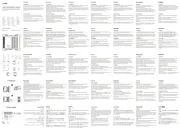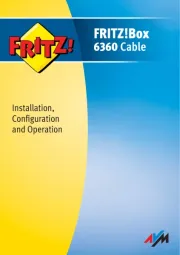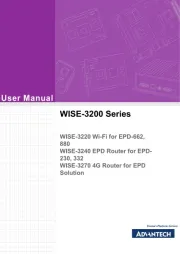Milan PacketBand Handleiding
Bekijk gratis de handleiding van Milan PacketBand (6 pagina’s), behorend tot de categorie Router. Deze gids werd als nuttig beoordeeld door 105 mensen en kreeg gemiddeld 4.7 sterren uit 53 reviews. Heb je een vraag over Milan PacketBand of wil je andere gebruikers van dit product iets vragen? Stel een vraag
Pagina 1/6

PAGE 1
Transition Networks, Inc.
Worldwide Headquarters:
10900 Red Circle Drive
Minnetonka, MN 55343 USA
tel: 952.941.7600 / 800.526.9267
fax: 952.941.2322
info@transition.com
http://www.transition.com
©2011 Transition Networks, Inc.
All trade marks are the property of their respective owners.
Technical information is subject to change without notice.
PacketBand-ISDN-P
Technical Specifi cation
Main Features
• Product versions supports up to 4 ISDN PRIs
• T1 and E1 ISDN available
• Transmits all data and voice protocols over packet networks
• Totally transparent to all data formats
• All PacketBands and interfaces synchronized
to the same clocks
• SIP Server option for centralized call routing
• Various clocking options with high quality clock recovery
• Any “B” channel can dial any other on the packet network, or
“break-out/in” via a gateway PacketBand to national/international ISDN
• Provides low-cost migration to IP networks for legacy equipment
• Low data overheads
• Confi gurable packet size
• Compensates for “jitter” or packet delay variation
• Re-orders packets
• Very low latency or processing delay
• Four 10/100 Base Ethernet ports; one to WAN and three local Ethernets
• Local Ethernets support Rate Limiting
• Quality of Service (QoS) options
• VLAN Tagging
• T1 Robbed-Bit Signalling available soon - covert between
T1/E1 ISDN and RBS
• Full timeslot cross-connectivity
• Versions support TE and/or NT (connects to a network and local equipment)
• Support for Fractional PRIs
• Euro-ISDN and various ANSI protocols
• E1 to T1 conversion
• a-Law to µ-Law conversion
• Support for contention or over-booking
• Call Progress Tone generation
• Number manipulation/conversion/LCR
• Automatic Primary/Secondary/Tertiary routes
• Routing profi les can be scheduled at different times of the day/week
• ISDN Layer 2 and Layer 3 message capture and log for analysis
• Easy and intuitive to confi gure via GUI management package
• Compact table-top with optional rack-mount extenders
• Approved (Telecoms, Emissions, Safety)
• RoHS compliant
The PacketBand-ISDN-P delivers transparent switched PRI ISDN
synchronous data services across asynchronous packet networks
for PRI interfaces.
Packet
Network
PABX
PRI Ports
PRI
P
t
PRI Ports
PRI Ports
ISDN Phone
Encriptor
MUX
ISDN Network
Encriptor
PABX
(For BRI units see the PacketBand-ISDN-B range)
(For non-switched TDM services see PacketBand-TDM.)

PAGE 2
• In-Coming Call Routing – ISDN traffi c can be routed based on DDI (MSN), CLI,
Sub-address, type of call (voice, fax, video etc.), the port or channel number of
an ISDN call or a combination of these fi elds. Calls can be routed to a specifi c
ISDN port, group of ISDN ports, an individual “B” channel, timeslot or into the
Packet Network.
• Out-Going Call Routing – ISDN calls are routed to a remote PacketBand over
the IP network either by user-confi gured rules or by using Patapsco’s SIP Server.
• SIP Server – An optional SIP Server can help with network confi guration and
routing parameter maintenance in larger systems where attached devices may
need to call any or many other locations as opposed to routing to a few central
sites. The SIP Server gives a central repository for all ISDN and IP routing tables,
simplifying the requirements in individual PacketBands. Multiple SIP Servers can
be confi gured for systems requiring exceptional resilience.
Calls can be converted to the correct PacketBand (identifi ed by IP address) based
on internal tables which use all or part of the number dialled. If the number is not
recognised the call can be routed to a “Gateway” PacketBand with access to the
national/international ISDN.
• Call Conversion – This feature enables PacketBand to add, edit or remove the
digits in any part of a call before it is forwarded on. An example application might
be where emergency numbers may need to be routed to a specifi c regional
offi ce and PacketBand can convert, for example, “112” into the correct regional
telephone number for that location. Another example would be where the dialled
number needs to be forwarded to a “hidden” destination number.
PacketBand is also able to delete/add/modify CLIs, down to an individual “B”
channel, and this can be useful for billing purposes.
• Call Barring – Block calls from certain CLI and/or calls with a certain DDI.
• Alternate Routes – PacketBand supports Primary, Secondary and Tertiary
routes. Should the primary destination be unavailable, the call will be routed to
the Secondary etc.
• PRI Port Options – Select NT or TE ports, choose E1 or T1, add tone
generation, and inhibit particular information elements on a per-port basis.
There are advanced options to allow connection to a wide range of ISDN devices
supporting specifi c operating protocol. Two pairs of ports are connected by
relays which will close on power failure, connecting the two ports, for resilience
purposes, via a metallic path.
Transition Networks, Inc.
Worldwide Headquarters:
10900 Red Circle Drive
Minnetonka, MN 55343 USA
tel: 952.941.7600 / 800.526.9267
fax: 952.941.2322
info@transition.com
http://www.transition.com
©2011 Transition Networks, Inc.
All trade marks are the property of their respective owners.
Technical information is subject to change without notice.
Overview
The PacketBand-ISDN range transports ISDN traffi c across packet networks. For
some types of device it is the only reliable and error free solution.
ISDN networks from carriers deliver clocked transparent 64k channels which
can be used by any type of traffi c anywhere in the world; PacketBand
does the same.
ISDN “B” channels are set up dynamically across the packet network giving
inter-connectivity between any device, and which can, importantly, “break-
out” into the global ISDN PSTN and access any other device world-wide. All
PacketBands are locked and synchronized to the network clock via an advanced
clock-recovery system ensuring reliable slip-free services for all applications.
This means not only can high-quality voice be transported over low-cost packet
networks using existing PBXs, but so can synchronous applications such as
videoconference units, voice codecs, encryptors, fax machines etc.
Not only does PacketBand deliver high-quality clock-locked transparent
channels as and when needed and where needed, it also has great fl exibility in
terms of adding CLIs for billing, converting numbers for emergency routing and
alternate routing and resilience options.
If you are a carrier looking to deliver reliable ISDN to customers, a military,
governmental or broadcast organization needing to transport synchronous ISDN,
or perhaps in another vertical or a corporate with some specifi c ISDN/IP issues,
PacketBand may be able to assist.
This document focuses on the PRI versions of PacketBand.
ISDN Routing and Features
• Type of User Traffi c – Any. PacketBand passes all “B” traffi c transparently in
a clock-locked or synchronous environment. All PacketBands in the network are
synchronized to a common clock.
• – Any “B” channel on any ISDN port can connectConnectivity
to any other.
• “Break-Out” – PacketBand can be connected to the real ISDN network as a
“gateway”, giving devices connected via the Packet Network access to/from all
other ISDN devices in the world.
• Logical Links – Each PacketBand-ISDN can be purchased supporting
different numbers of Logical Links. Each Logical Link is a connection of up to 32
“B” channels between any two PacketBands. For example, if there was one “B”
channel established between two PacketBands that would be one Logical Link.
If a second call is established, from either direction between the same two units,
this call would be incorporated into the same Link to reduce overheads. Logical
Links are only assigned when in use so once a connection has been cleared, the
Link is available for use to any other PacketBand.
PABX
BRI Ports
SIP
Server
BRI
I
P
t
BRI Ports
PRI Po
PRI
Packet Network
s
ISDN Network
r
ts
ISDN Network

PAGE 3
Transition Networks, Inc.
Worldwide Headquarters:
10900 Red Circle Drive
Minnetonka, MN 55343 USA
tel: 952.941.7600 / 800.526.9267
fax: 952.941.2322
info@transition.com
http://www.transition.com
©2011 Transition Networks, Inc.
All trade marks are the property of their respective owners.
Technical information is subject to change without notice.
Clocking
• Adjustable Clock Recovery – PacketBand’s clock recovery is very accurate
and based on a number of software algorithms. Customizable options enable
optimum clock recovery across the network.
• – Dynamic negotiation to select best clock source available. Clock Sourcing
• “Hold-Over” – When calls are established PacketBand stores the accurate
recovered clock in a sophisticated PLL (Phase Locked Loop). This is used as the
clock reference when no calls are connected to the PacketBand (unless it has
an ISDN port connected which provides clock), still delivering an accurate clock
to attached devices.
• – Typically 40-250ppb (parts per billion).Clock Accuracy
Packet Network Features
• Selectable Protocol – Choose from Pseudo-wire over IP or Pseudo-wire over
IP including UDP/RTP.
• Frames Per Packet – User-selectable size of packets to optimize performance.
• – Confi gure a VLAN by adding tags to packets on a per VLAN
Logical Link basis.
• – Confi gure QOS settings for each PacketBand unit, TOS and Diff Serv.QOS
• Packet Prioritization – Set priorities for the handling of packets based on
port, Diff Serv codepoint value or 802.1p value.
• Rate Limiting – Limit packet rates from/to any Ethernet port by port or priority.
• NAT Traversal – Set a Public IP Address to allow NAT traversal.
• Sniffer Port – Confi gure a spare Ethernet port to receive RX and/or TX packets
mirrored from any/all other PKT Port(s). This allows for connection of another
device to monitor Packet traffi c.
• Auto Negotiation – Confi gure PacketBand to Auto-Negotiate Speed and
Duplex settings, or force the unit to use Full/Half Duplex and 10/100M.
• Oscillator Modules – Select from 1 PPM or two different Stratum 3 Oscillators
(TCXO or OCXO) for enhanced clocking across a packet network.
Performance
• Clock Recovery and Accuracy
The accuracy and stability of recovered clocks across the Packet Network is
the key to this application. PacketBand employs intelligent algorithms to look
at trends/hysteresis, the receipt of special “timing packets” from its partner
PacketBand as well as the use of the jitter buffer.
Additionally, a sophisticated and dynamic method of always sourcing the best
available clock reference is employed.
The overall effect is that all PacketBands are, in effect, locked to common clocks
meaning any device can communicate with any other, and communicating via
gateways into/out of the real ISDN can be performed error-free.
• End-to-End Delays
The total end-to-end delay between two DTEs using PacketBand is made up
of four elements; the processing delay of the PacketBand to perform the roles
it undertakes, the delay to data when building and buffering a packet prior to
shipping over the IP network and the opposite at the receive end, necessary
buffering to handle “jitter” within the network (the difference in transit time for
a fast packet and a slow one), and the actual delay across the managed IP
network. These are described below.
1. Processing delay - The latency or processing delay through each PacketBand
is optimized to be as low as possible. Typical processing delay is less
than 1msec.
2. Confi gurable Packet Sizes - An IP packet has a fi xed amount of overhead so
the larger the data element of a packet, the smaller the overhead but the longer
the user traffi c is delayed whilst a packet is formed for transmission. The size
of packets is user-confi gurable. This delay is typically in the 0.5-4msecs range.
3. Jitter - IP networks differ in how consistently packets pass through. Some
packets take less time than others. PacketBand provides a synchronous clocked
circuit to the DTEs and therefore has to have data available with the steady clock
pulse. PacketBand buffers the fast packets so as to make sure the slow ones
arrive in time. The amount of buffering is user-confi gurable and will depend
upon the performance of the IP network. Note that this is only required on the
PacketBand receiving data from the IP network.
4. Transit Delay - All IP networks have different average transit delay these vary
depending upon the number of “hops” and if satellites are involved. Typically
domestic links are very fast, intercontinental around 60msec and a satellite can
add up to 250msecs. Please consult your network supplier.
Summary: between any pair of PacketBands on a terrestrial network, the most
signifi cant element contributing to latency is the size of the Jitter Buffer (user
confi gurable) and this varies as a direct result of the performance of the network.
PABX
Carrier inter-connect
PRIs
Low-cost PRI & BRI delivery
for METRO and IP providers
Access to ISDN PSTN and
to inter-connect partners.
Customer 1
Customer 2
Customer 3
Central Site
Packet
Network
y
s.
ISDN
Network
Product specificaties
| Merk: | Milan |
| Categorie: | Router |
| Model: | PacketBand |
Heb je hulp nodig?
Als je hulp nodig hebt met Milan PacketBand stel dan hieronder een vraag en andere gebruikers zullen je antwoorden
Handleiding Router Milan

13 Februari 2024
Handleiding Router
- Arris
- Vimar
- Razer
- Rosewill
- Keewifi
- Tenda
- Predator
- SIIG
- Netgear
- OneAccess
- Peak
- Teltonika
- Gembird
- Nilox
- Keenetic
Nieuwste handleidingen voor Router

18 Augustus 2025

18 Augustus 2025

18 Augustus 2025

12 Augustus 2025

5 Augustus 2025

4 Augustus 2025

30 Juli 2025

29 Juli 2025

29 Juli 2025

29 Juli 2025